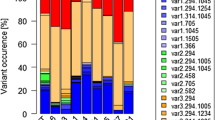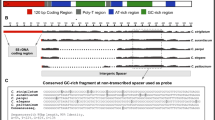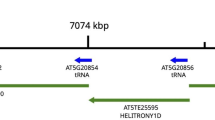Abstract
The DNA of the cruciferMatthiola incana (Brassicaceae, Capparales) has been investigated for the pattern of sequence interspersion and RNA transcription. A short period pattern of interspersion (Xenopus-like interspersion pattern) is predominant (60%). Similar to a series of other Angiosperms (tobacco, soybean, parsley and some cereals) repetitive clusters orinter-se interspersion patterns of repetitive DNA occur inMatthiola genome and amount to 12%. From the hybridization of single copy DNA with poly(A)−-RNA and from cDNA/poly(A)+-RNA and cDNA/poly(A)−-RNA hybridizations a number of about 9,400 active genes can be estimated forM. incana seedlings. Both RNA constituents (poly(A)+-RNA and poly(A)−-RNA) contain mainly the same protein-coding mRNA sequences. Total mRNA is amounting to about 4% of theM. incana RNA population. A total of 1.2% (or about 30% of mRNA) of theM. incana RNA is represented by polyadenylated mRNA sequences. About 3.6% of single copy DNA hybridizes with poly(A)−-RNA. Approximately 7% of theM. incana genome, organized in a short period pattern of DNA sequence interspersion, is transcribed into RNA sequences (mRNA). About 6% of clustered repetitive DNA is expressed into RNA sequences such as rRNA and tRNA. Approximately 1.6 × 106 rRNA, 1.75 × 107 tRNA and 3.7 × 105 mRNA molecules are present perMatthiola seedling cell. The transcription rate of single rRNA and tRNA genes can be estimated to be about 1,400 or 1,100 copies per gene, respectively.
Similar content being viewed by others
References
Britten, R. J., Graham, D. E., Neufeld, B. R., 1974: Analysis of repeating DNA sequences by reassociation. — In:Grossman, L., Moldave, K., (Eds.): Methods in Enzymology29 E, 363–418, 1974. — New York: Academic Press.
Dawkins, R., 1976: The Selfish Gene. — Oxford: University Press.
Doolittle, W. F., Sapienza, C., 1980: Selfish genes, the phenotype paradigm and genome evolution. — Nature284, 601–603.
Goldberg, R. B., 1978: DNA sequence organization in the soybean plant. — Biochem. Genetics16, 45–68.
——, 1978: Sequence complexity of nuclear and polysomal RNA in leaves of the tobacco plant. — Cell14, 123–131.
Gollmer, I., 1980: Untersuchungen zur Genexpression während der Entwicklung und Differenzierung der BlütenpflanzeMatthiola incana. — Dissertation, Tübingen.
Graham, D. E., Neufeld, B. R., Davidson, E. H., Britten, R. J., 1974: Interspersion of repetitive and non-repetitive DNA sequences in the sea urchin genome. — Cell1, 127–137.
Grierson, D., Covey, S., 1975: Changes in the amount of ribosomal and poly(A)-containing RNA during leaf development. — Planta127, 770–786.
——, 1977: Ribonucleic acids from the higher plantMatthiola incana. Molecular weight measurements and DNA/RNA hybridization studies. — Biochem. Biophys. Acta475, 424–436.
Gurley, W. B., Hepburn, A. G., Key, J. L., 1979: Sequence organization of the soybean genome. — Biochem. Biophys. Acta561, 167–183.
Hamer, D. H., Thomas, C. A. Jr., 1974: Palindrome theory. — J. Molec. Biol.84, 139–144.
Harbers, E., 1975: Nukleinsäuren — Biochemie und Funktion. 2. Auflage. — Stuttgart: Georg Thieme Verlag.
Hemleben, V., Ermisch, N., Kimmich, D., Leber, B., Peter, G., 1975: Studies on the fate of homologous DNA applied to seedlings ofMatthiola incana. — Eur. J. Biochem.56, 403–411.
——, 1977: The use of equilibrium centrifugation in actinomyein caesium chloride for the purification of ribosomal DNA. — Pl. Sci. Lett.9, 129–135.
Kamalay, J. C., Goldberg, R. B., 1980: Regulation of structural gene expression in tobacco. — Cell19, 935–946.
Kiper, M., Herzfeld, F., 1978: DNA sequence organization in the genome ofPetroselinum sativum (Umbelliferae). — Chromosoma65, 335–351.
——, 1979: Gene number estimates in tissues and cells. — Pl. Syst. Evol. Suppl.2, 129–140.
Lindberg, U., Persson, T., 1972: Isolation of messenger RNA from KB cells by affinity chromatography on polyuridylie acid covalently linked to sepharose. — Eur. J. Biochem.31, 246–254.
Maniatis, T., Jeffrey, A., Kleid, D. G., 1979: Nucleotide sequence of the rightward operator of phage lambda. — Proc. Natl. Acad. Sci. USA72, 1184–1188.
Nagl, W., 1976: Zellkern und Zellzyklen. — Stuttgart: Eugen Ulmer Verlag.
Orgel, L. E., Crick, F. H. C., 1980: Selfish DNA: The ultimate parasite. — Nature284, 604–607.
Rimpau, J., Smith, D., Flavell, R., 1978: Sequence organization analysis of the wheat and rye genomes by interspecies DNA/DNA hybridization. — J. Mol. Biol.123, 327–359.
Silflow, C. D., Hammett, J. R., Key, J. L., 1979: Sequence complexity of polyadenylated ribonucleic acid from soybean suspension culture cells. — Biochemistry18, 2725–2731.
Straus, N. A., 1976: Repeated DNA in eucaryotes. — In:King, R. C., (Ed.): Handbook of Genetics5: Molecular Genetics. — New York, London: Plenum Press.
Sutton, W. D., 1971: A crude nuclease preparation suitable for use in DNA reassociation experiments. — Biochim. Biophys. Acta240, 522–531.
Thompson, W. F., 1977/78: Perspectives on the evolution of plant DNA. — Carnegie Inst. Washington Yearb.77, 310–316.
Walbot, V., Goldberg, R., 1979: Plant genome organization and its relationship to classical plant genetics. — In:Hall, T. C., Davies, I. W., (Eds.): Nucleic Acids in Plants, 4–36. — Boca Raton, Florida: CRC Press.
Wenzel, W., Hemleben, V., 1979: DNA reassociation studies and considerations on the genome organization and evolution of higher plants. — Pl. Syst. Evol. Suppl.2, 29–40.
Wenzel, W., Hemleben, V., 1982: A comparative study of genomes in Angiosperms. — Pl. Syst. Evol.139, 209–227.
Wickens, M. P., Buell, G. N., Schimke, R. T., 1978: Synthesis of double-stranded DNA complementary to lysozyme, ovomucoid, and ovalbumin mRNAs. — J. Biol. Chem.253(7), 2483–2495.
Williamson, R., Morrison, M., Lanyon, G., Eason, R., Paul, J., 1971: Properties of mouse globin messenger ribonucleic acid and its preparation in milligram quantities. — Biochemistry10, 3014–3031.
Zimmerman, I. L., Goldberg, R. B., 1977: DNA sequence organization in the genome ofNicotiana tabacum. — Chromosoma59, 227–252.
Author information
Authors and Affiliations
Rights and permissions
About this article
Cite this article
Wenzel, W., Hemleben, V. DNA sequence organization and RNA complexity inMatthiola incana (Brassicaceae). Pl Syst Evol 140, 75–86 (1982). https://doi.org/10.1007/BF02409898
Received:
Issue Date:
DOI: https://doi.org/10.1007/BF02409898




